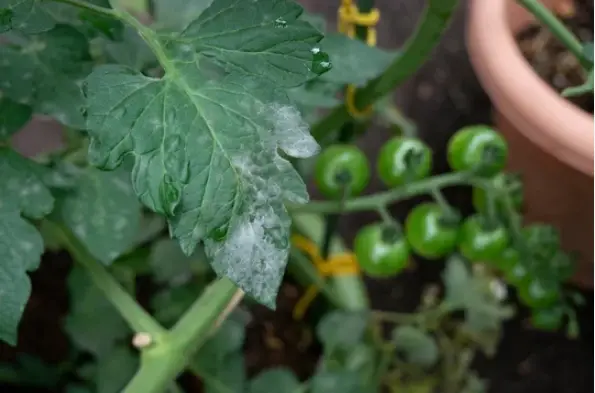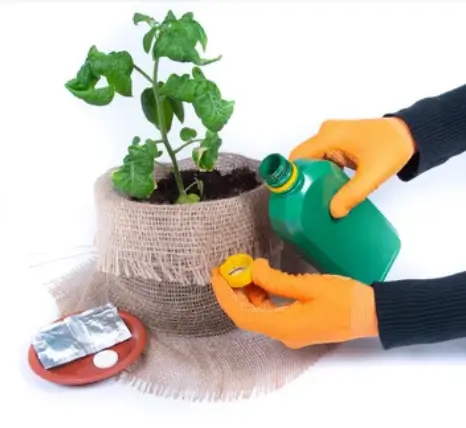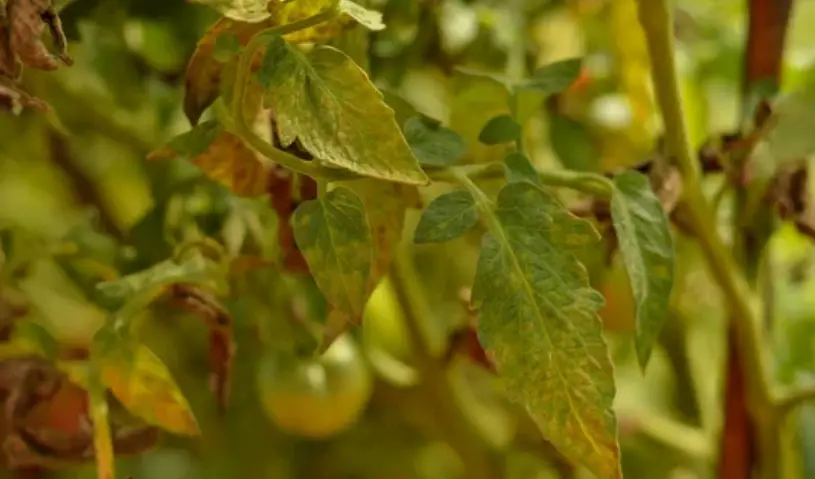One of the most popular garden staples, tomatoes are prized for their adaptability and capacity to improve a variety of cuisines.
Unfortunately, tomato plants are susceptible to several pests and illnesses, just like any other crop.
White mold, a fungus disease that may destroy tomato crops if left unchecked, is one of the sneakiest enemies that gardeners may encounter.
This thorough guide will cover all aspects of white mold on tomato plants, from its causes and symptoms to practical precautions and remedial measures.
By the end, you’ll have the information you need to safeguard your tomato plants and guarantee a plentiful crop.

What Are White Mold on Tomato Plants?
White mold, scientifically known as Sclerotinia sclerotiorum, is a fungal disease that affects a wide range of crops, including tomatoes.
It is often referred to as “white mold” due to the fluffy, cotton-like mycelium it produces as it spreads.
This mold typically thrives in cool, wet conditions, making it a common threat in regions with temperate climates.
How does white mold spread?
White mold primarily spreads through the production of tiny, durable resting structures called sclerotia. These sclerotia can survive for several years in the soil and are capable of infecting plants when conditions become favorable. White mold spores can also be carried by the wind, making it a challenge to prevent the disease from taking hold.
Related Post: mold on banana stem
Recognizing White Mold Symptoms
White mold can be difficult to detect in its early stages, but as the disease progresses, symptoms become more apparent. Being able to recognize these signs is crucial for effective management.
Initial Symptoms
- Small, Water-Soaked Lesions: The first signs of white mold are small, water-soaked lesions on the lower leaves of the tomato plant. These lesions are often light brown and may be mistaken for other issues at first.
- Stem Lesions: As the disease advances, it can cause lesions on the stem near the soil line. These lesions are typically sunken and may be covered with the characteristic white mycelium.
Advanced Symptoms
- White, Cottony Growth The most distinctive feature of white mold is the white, cotton-like growth that covers infected areas. This growth can appear on leaves, stems, and even fruit.
- Wilting and Dying Plant: As white mold advances, the affected plant will wilt and eventually die. This is due to the fungus clogging the plant’s vascular system, disrupting the flow of nutrients and water.
- Sclerotia Formation: In later stages, the fungus produces sclerotia, which are small, hard, black structures that can be found within the white, fluffy mycelium. These sclerotia serve as a source of new infections.

White Mold on Tomato Plants
Causes of White Mold on Tomato Plants
High Humidity and Moisture
White mold thrives in humid and moist environments. Excessive rainfall, high humidity levels, or overwatering can create the ideal conditions for the fungus to develop.
Crowded Planting
Planting tomatoes too close together can limit air circulation and increase humidity between the plants, creating a favorable environment for white mold to spread.
Infected Crop Residues
If you’ve previously had white mold in your garden, the fungal sclerotia can remain in the soil. When you plant tomatoes in the same area, the disease can resurface.
Weakened Plants
Weak or stressed tomato plants are more susceptible to white mold. Poor nutrition, damage, or other diseases can make your tomatoes more vulnerable.
Prevention Strategies
Preventing white mold on tomato plants involves a combination of cultural practices and careful monitoring. Here are some effective strategies to keep your tomatoes safe.
Proper Plant Spacing
Give your tomato plants enough space to promote air circulation. This reduces humidity levels between plants, making it less likely for white mold to take hold.
Watering Practices
Avoid overwatering your tomato plants. Water at the base of the plants and use mulch to keep the soil moisture levels consistent.
Crop Rotation
Practice crop rotation to reduce the risk of white mold. Avoid planting tomatoes in the same area where they or other susceptible crops were grown in the previous season.
Disease-Resistant Varieties
Select tomato varieties that are more resistant to white mold. Research and choose varieties that are known to withstand fungal diseases.
Pruning and Trellising
Properly prune and trellis your tomato plants to improve air circulation and reduce humidity around the plants.
6. Clean Garden Practices
Regularly remove and destroy infected plant material to prevent the disease from spreading further. This includes infected leaves, stems, and any plant debris.
Fungicide Application
If white mold is a recurring problem in your area, consider using fungicides. Consult with your local agricultural extension office or garden center for recommendations on effective fungicides.
Managing White Mold
Despite your best efforts, white mold can sometimes still infect your tomato plants. In such cases, quick action is crucial to minimize damage.
Isolate and Remove Infected Plants
As soon as you notice the symptoms of white mold, isolate the infected plant to prevent the disease from spreading to healthy ones. Remove and dispose of the affected plant material away from the garden.
2. Prune Affected Parts
If the infection is not widespread, you can try pruning away the affected parts of the plant. Be sure to sterilize your pruning tools between cuts to prevent the spread of the disease.
Fungicide Application
Fungicides can be effective in managing white mold, but they are most successful when used as a preventive measure or in the early stages of infection. Follow the instructions on the product label for proper application.
Biological Control
Some beneficial microorganisms, such as Trichoderma species, can help suppress white mold. These can be applied as soil drenches or incorporated into potting mix.
Remove and Destroy Sclerotia
To prevent future outbreaks, dig up and remove any sclerotia from the soil. Discard them in a sealed bag to prevent recontamination.
Soil Management
Soil plays a critical role in the development and persistence of white mold. Proper soil management practices can significantly reduce the risk of white mold infection:
Well-Draining Soil
White mold thrives in moist conditions, so well-draining soil is crucial. Improve soil drainage by adding organic matter such as compost or well-rotted manure. Well-draining soil prevents water from pooling around the roots and reduces humidity levels in the root zone.
Raised Beds
If you’re dealing with consistently wet or poorly draining soil, consider gardening in raised beds. Raised beds can improve drainage and limit the risk of white mold infection by keeping the roots above ground level.
Companion Planting
Companion planting is a practice where you grow certain plants together to improve each other’s health and deter pests and diseases. Here are some companion plants that can help reduce the risk of white mold:
Marigolds
Marigolds are known for their ability to repel various pests and diseases, including white mold. Plant them near your tomatoes to create a natural barrier against the fungus.
Basil
Basil not only enhances the flavor of tomatoes but also acts as a natural fungicide. Plant basil near your tomato plants to help protect them from white mold.
Organic Remedies

If you prefer organic gardening methods, there are several natural remedies you can employ to manage white mold:
Neem Oil
Neem oil is a natural pesticide and fungicide that can help control white mold. Mix neem oil with water and spray it on your tomato plants as a preventive measure.
Baking Soda Solution
A simple solution of baking soda and water can help reduce the severity of white mold. Mix 1 tablespoon of baking soda with a gallon of water and spray it on your plants every 7–10 days.
Monitoring Humidity Levels
Regularly monitoring humidity levels in your garden can help you stay ahead of white mold. You can use a simple weather station or a hygrometer to keep track of humidity levels. If the humidity is consistently high, consider using fans to improve air circulation around your plants.
Prevention through Seed Selection
Choosing the right tomato seeds can make a difference in preventing white mold. Look for seeds that are labeled as disease-resistant. Tomato varieties such as ‘Defiant,’ ‘Mountain Merit,’ and ‘Iron Lady’ are known for their resistance to white mold and other common tomato diseases.
Post-Harvest Practices
Preventing white mold is not limited to your growing season. Post-harvest practices can also impact your future crops.
Clean Your Garden Tools
White mold spores can stick to garden tools and equipment. After working in an infected garden, be sure to thoroughly clean and sanitize your tools to prevent cross-contamination.
Crop Rotation
Rotate your crops each season to disrupt the life cycle of white mold. By planting tomatoes in different areas of your garden from year to year, you reduce the likelihood of a recurrent infection.
Gardeners may find it frustrating to deal with white mold on tomato plants, but with the right management and prevention techniques, you can save your tomato harvest.
You can considerably lower the chance of white mold by identifying the early signs, comprehending the reasons, and putting preventative measures into practice.
In the unfortunate event that white mold does occur, prompt and efficient response can aid in reducing the harm and safeguarding your upcoming tomato harvests.
You’ll be better able to enjoy big, robust tomatoes directly from your garden if you have these gardening tricks in your toolbox.




